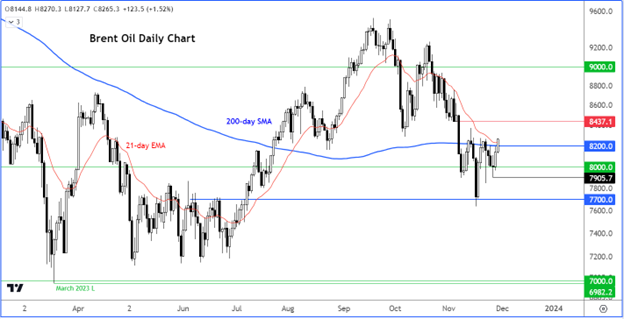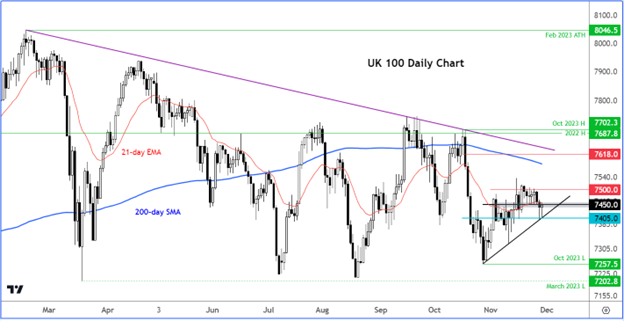In sharp contrast to other European and US indices, the UK’s FTSE has spent much of November in consolidation mode, keeping inside the range from the month before, states Fawad Razaqzada of Trading Candles.
However, the German DAX index was up again today, rising some +0.85% to lead European indices, reaching its best level since August. The German index is now up for the 5th consecutive week, boosted by peak global interest rates narrative. Yet, the FTSE is doing its own thing, minding its own business. But for how long will it continue underperforming? Surely at some stage, even the FTSE might start to look attractive, at least on a relative basis.
FTSE Analysis: Can Rebounding Oil Prices Fuel Rally in Energy Stocks?
The potential shift towards a more dovish stance by central banks has sparked optimism in global markets, as signs indicate a gradual return of global inflationary pressures to normal levels. The focus this week on the economic data calendar is on US GDP and core PCE inflation data. Any further signs of weakening growth and/or inflationary pressures could further support the already impressive rally on Wall Street.
In contrast, the UK is currently facing challenging times, characterized by sluggish inflation reduction and the expectation of prolonged high-interest rates. This has hindered the FTSE from extending its earlier-year rally after reaching a new all-time high in February. Subsequently, the FTSE has grappled with sustaining positive momentum, facing challenges linked to China's economic situation, the UK's domestic economic struggles, elevated global interest rates, and more recently, the slump in oil prices holding back oil majors like BP and shell.
Nevertheless, recent positive economic indicators from China and the UK suggest a potential turnaround, hinting that the most challenging period may be in the past. This optimism is reinforced by the diminished macroeconomic concerns compared to a few months ago. What’s more, crude prices have found support in the last couple of days ahead of the OPEC’s meeting on Thursday, and should oil prices stay higher, then this could underpin the likes of BP and Shell, and in turn provide the FTSE a much-needed lift.
Crude Oil Analysis: Brent Rises Above 200-day Average Ahead of OPEC+ Meeting
Oil prices were up for the second consecutive day at the time of writing on Thursday, with Brent oil clearing key resistance and the 200-day average around $82.00. Oil investors are expecting the OPEC+ to extend curbs on supplies into 2024. The sharp declines over the past several weeks mean investors have now priced in much of the negative influences related to the demand side, with global data being poor for much of this year and US stockpiles rising sharply in recent weeks, all to suggest that demand is weaker than expected.
The recovery comes after oil prices took a tumble last week after OPEC and its allies including Russia (AKA OPEC+) postponed a ministerial meeting by three days to Thursday, November 30. There are differences in production targets for African oil producers. Saudi is dissatisfied with some of the other OPEC+ members who are not complying with the cuts. According to Reuters, those differences have now narrowed, with the group moving closer to a compromise. But while the group’s de facto leader Saudi Arabia seeks quota cuts, some of the other members are resisting, according to some reports. All told, I expected a breakthrough in the talks. Saudi Arabia is likely to roll over its additional voluntary cut of 1 million barrels per day (bpd) into next year, and Russia should likewise extend its cuts, at least until the first quarter of 2024. If so, this should alleviate some of the selling pressure on oil prices moving forward.

FTSE Technical Analysis
As mentioned, the FTSE has been unable to partake in the same upward momentum witnessed in other European and US stock markets over the past several weeks. The FTSE is lagging and needs to make up ground. There had been some positive developments in more recent days as the FTSE climbed back above the 21-day exponential moving average and overcame resistance at the 7450 level. But a two-day sell-off sent the index back below this level, which must now be reclaimed on a daily closing basis to tilt the balance back in the bulls’ favor.
Despite consistently forming lower highs throughout the year, the UK index has not experienced a significant sell-off. Instead, it has predominantly held within a broad consolidation range. Remarkably, the index has successfully maintained levels above the March low of 7202, even in the face of several bearish attempts to breach this threshold—twice during the summer and once in October. The impressive bullish resilience exhibited amid various macro risks suggests that the index, having endured relatively minimal damage, might now be poised to rise on the back of positive developments. There is a good possibility that we might see a rally aiming to test the 200-day average and previous resistance in the 7600-7620 range shortly. To start an ascend towards that level, short-term resistance at 7450 must be taken out first.

To learn more about Fawad Razaqzada visit TradingCandles.com





















